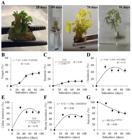ABSTRACT:
Cochlospermum regium roots are used in popular medicine and its extract has diverse phytochemical molecules some with antimicrobial activity, consequently exposing this specie to genetic erosion risks. Thus, the objective of this study was to develop an in vitro multiplication protocol using chemical sterilization of culture medium. Therefore, explants obtained from apical buds of C. regium seedlings were inoculated into with 0.05mg L-1 NAA and 1mg L-1 BAP sterilized by chemical agent sodium hypochlorite (NaOCl) at 0.001%, 0.003% and 0.005% of active chlorine (Cl). Autoclaved culture medium was used as control. Result showed that the contamination by bacterial at 91 days of cultivation was significantly (P<0.05) controlled by autoclaving, 0.001% and 0.005% Cl. Moreover, the callus induction in the culture medium with 0.001% and 0.005% Cl was, respectively, 30% and 20% major than autoclaving sterilization. There was not significant (P<0.05) in the percentage of shoot induction among the sterilization preparations methods, and 65% of the explants survived in the presence of culture medium with 0.005% Cl. Histological analyses indicated that the Cl did not have any deleterious effects on morphogenic events. These results indicated that the chemical sterilization using 0.001% - 0.005% Cl controlled the fungal and bacterial multiplication in the culture medium and no affected the C. regium explants development, becoming it an alternative to autoclaving method.
Key words:
autoclaving; cerrado biome; active chlorine; in vitro cultivation

 Thumbnail
Thumbnail
 Thumbnail
Thumbnail
 Thumbnail
Thumbnail


